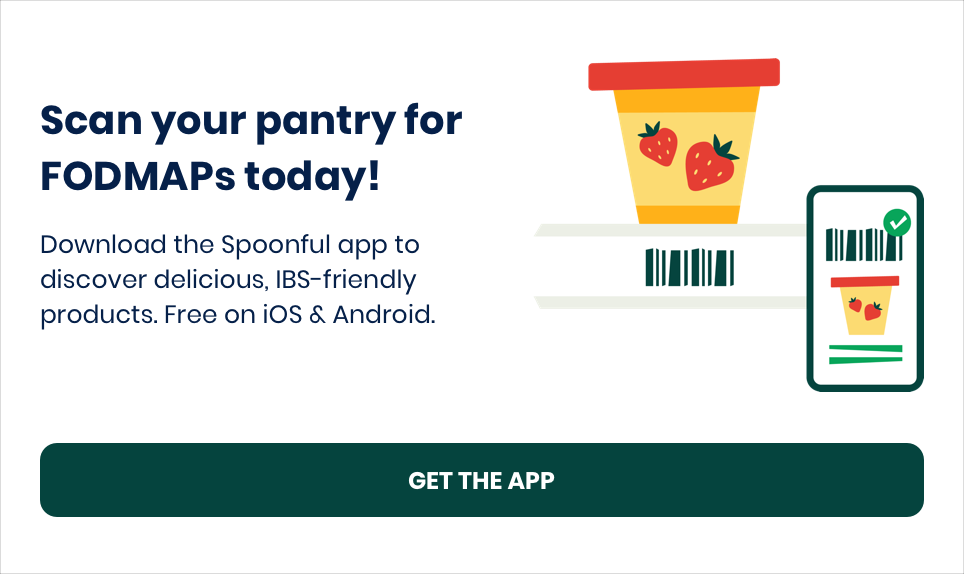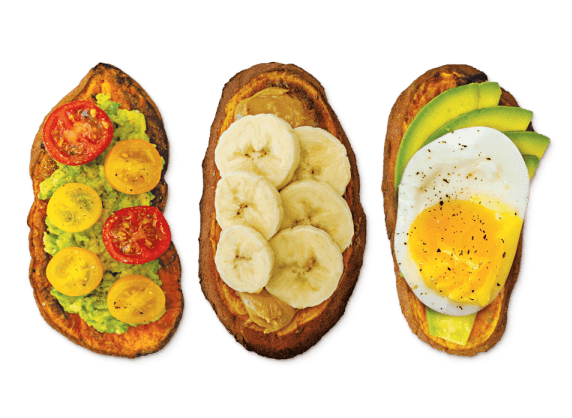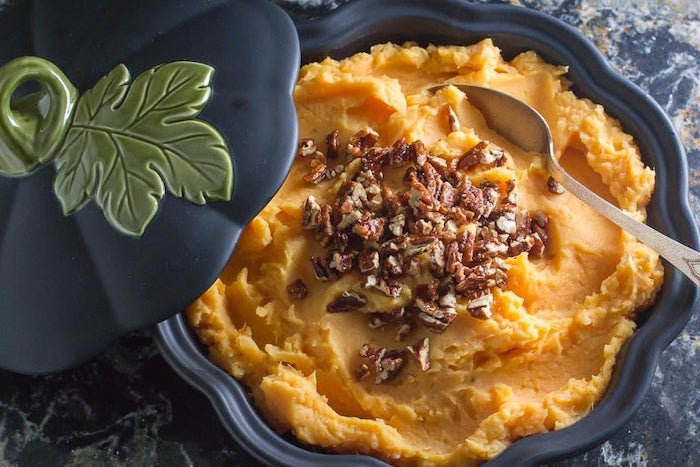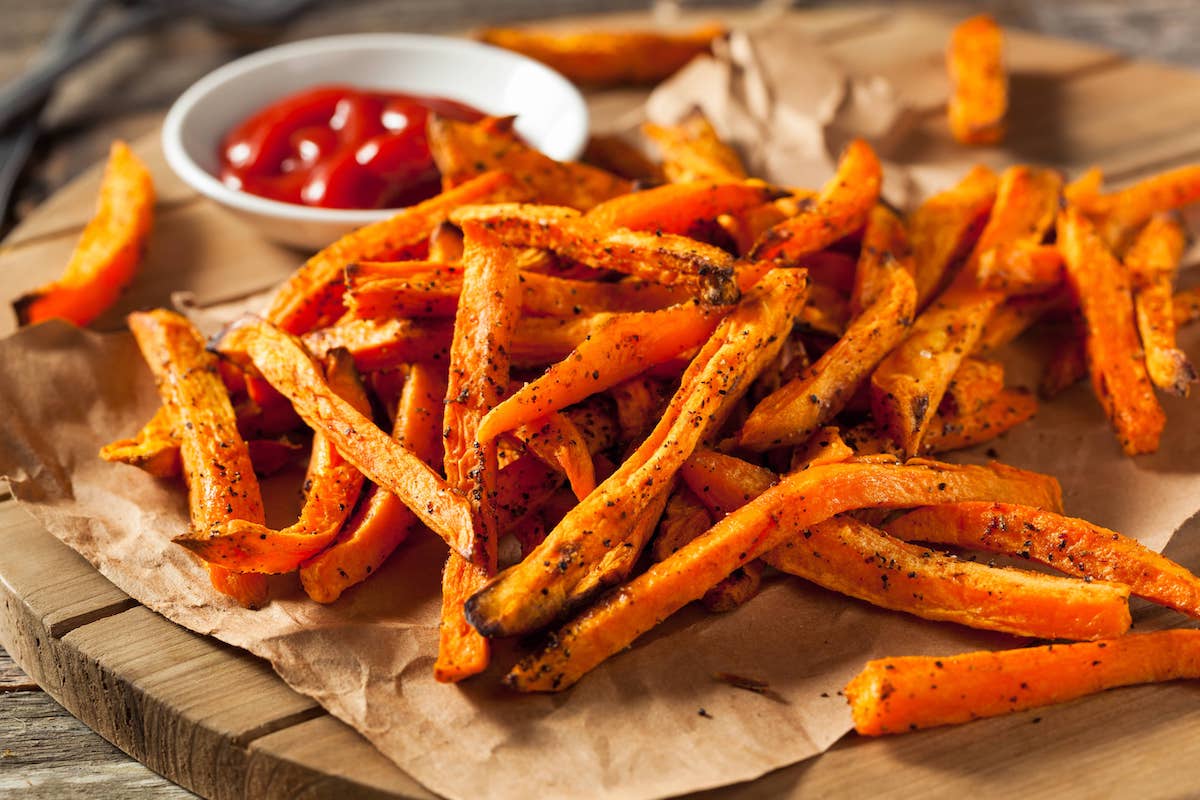Sweet potatoes are by far one of my favorite vegetables. First off, they are a nutrition powerhouse. Each serving is packed full of fiber, a huge dose of vitamins A & C, potassium, and beta carotene. Aside from a stellar nutrition profile, what other vegetable finds its way into both savory and sweet recipes? In this week’s post, I answer the question: Are sweet potatoes low FODMAP? (hint: it’s good news), and provide a number of recipes, products, and uses for my favorite tuber.

Serving Sizes
Fortunately, sweet potatoes do fit into the low FODMAP diet, and just like many other vegetables, it’s all about portion size.
A low FODMAP serving size of sweet potatoes is ½ cup and a slightly larger portion of ¾ cup pushes the mannitol load into a moderate zone.
Ideally, one should aim for green colored serving sizes when following the low FODMAP diet. For those who adore this irresistible tuber, you may find it hard to keep to this portion. Just remember, you can enjoy ½ cup several times each day if spaced out 3-4 hours. Sweet potatoes for breakfast, lunch, and dinner sounds pretty good to me!
Read more: Managing IBS with Low FODMAP Portions
Sweet Potatoes vs Yams
Did you know? Sweet potatoes and yams are often used interchangeably, but they are actually two different vegetables. Sweet potatoes are long and tapered at each end and vary in color from yellow, orange, red, brown, purple, and beige. The variety with the dark orange or reddish skin are often labeled as yams in the grocery store, however these are actually sweet potatoes.
A real yam is not commonplace and actually looks more like a yucca with a bark-like skin. Yams also have a pretty starchy (not sweet) flavor profile. There is a low FODMAP serving size of yams as well in case you enjoy these.
Fun Fact: Sweet potatoes are not actually potatoes either! They are a root vegetable also known as a tuber.
The Mannitol Challenge
For those of you who are moving through the FODMAP Reintroduction Phase, consider choosing sweet potatoes as your mannitol challenge or “test food”. I recommend incorporating them into your diet on three days in a given week in increasing portions based on tolerance.
Challenge Example
- Day 1: Enjoy one cup of sweet potatoes at one meal.
- Day 4: Based on personal tolerance, increase serving to 1 1/2 cups or maybe even 2 cups if symptoms remain at bay.
- Day 7: Push your serving to 2 1/2 to 3 cups of sweet potatoes at one meal.
Hopefully, you will pass this challenge without any symptoms. If you do experience a reaction, use this experiment to determine your personal threshold.
9 Simple Ways to Enjoy Sweet Potatoes
There are so many ways to enjoy this lovely vegetable – baked, roasted, fried, steamed, boiled, mashed, grilled, or even raw. Sweet potatoes can easily be called a low FODMAP comfort food as they help warm the belly, taste amazing in a myriad of soul-satisfying recipes, and conjure up precious holiday memories.
1. Baked
My favorite simple way to prepare sweet potatoes is to just bake them whole in their skin until they are really soft and sweet. Oftentimes, I throw a half dozen or so in a large pan, so I can have leftovers for quick sides on busy weekdays. Cooking time varies from 30-60 minutes at 400 degrees Fahrenheit based on the size of your potatoes.
2. Fries
If you have a bit more time after baking your potato, peel and cut it into small uniform pieces, coat with your oil of choice, and season to taste (low FODMAP spices of course).
Make sure you give the fries a little space so they can caramelize. If they are too close together, they tend to steam and get a little mushy. I recommend keeping the oven around 400 degrees Fahrenheit and checking the potatoes every 10-15 minutes until they are done.
3. Mashed
Mashed sweet potatoes outdo mashed white potatoes any day in my mind. I’m a dietitian though, so this is kind of expected, right?
You can either boil or bake your sweet potatoes with this easy, low FODMAP recipe. It only takes 20-30 minutes to boil a sweet potato. Once cooked, mash with an electric blender or potato masher and add your favorite ingredients – lactose free milk for a more creamy dish, cinnamon, nutmeg, butter, maple syrup, brown sugar, salt, or pepper.
4. Raw (for the brave)
As sweet potatoes cook, the starch converts into sugar, which provides the sweet flavor profile. Eating raw sweet potatoes is a thing, however they do not taste as sweet due to the lack of heat.
Raw potatoes can be a little tough and may contribute to IBS symptoms, but if you want to try, I would add only a little grated to a salad or smoothie.
5. Toast
Sweet potato toast? Oh yes. Slice your peeled sweet potato into ¼-inch slices and toast (just like bread) in your toaster or toaster oven. It can take up to 6 times or so to soften and crisp up.

Once toasted, top with butter, peanut or almond butter, maple syrup, eggs, ⅛ avocado, cream cheese, or any other low FODMAP sweet potato spread. For a simple alternative, check out my new favorite product, Caulipower Sweet PotaToasts.
6. Spirals
Spiralize your sweet potato (or purchase pre-spiralized sweet potatoes from the produce aisle) and sauté in oil for 5-7 minutes.
7. Salad Topper
Toss cooked sweet potatoes in your salad. My fancy winter salads often include these, pomegranate seeds, and a little goat cheese when feeling festive.
8. Pureed
Enjoy pureed sweet potato in pancakes, pies, or your favorite low FODMAP baked good. Sweet potato puree is an easy swap for pumpkin puree and can be used to replace some of the fat (butter and oil) in many recipes. Look at this simple recipe for Sweet Potato Pancakes by Kitchn!
9. Smoothies
Freeze your leftover small pieces of sweet potato and toss a few in your morning smoothie for a creamy addition.
Sweet Potato Products Are On The Rise
Have you noticed sweet potatoes popping up in foods such as crackers, chips, and cookies? I feel pretty good stating that most sweet potato crackers or chips are low FODMAP as long as high FODMAP ingredients are not added.
If the total carbohydrate content is approximately 15 grams, I feel even more confident as this is how many carbs are in ½ cup of sweet potatoes. An ounce of sweet potato crackers or chips likely falls within a low FODMAP serving size. Here are a few of my favorites:
Read more: 10 New Low FODMAP Products That Will Spice Up Your Pantry
Our Favorite Recipes

If you have more time and want to enjoy some more sweet potato recipes, here are some of my favorites.
- Low FODMAP Mini Sweet Potato & Carrot Casseroles by A Little But Yummy
- Low FODMAP Mashed Sweet Potatoes with Candied Spiced Pecans by FODMAP Everyday
- Low-FODMAP Sweet Potato Muffins with Streusel (Crumble) Topping by Rachel Paul
- All-Time Favorite Sweet Potato Pudding by AllRecipes – swap milk with lactose free milk and keep your serving size to ½ cup.
We hope this article helps you love the humble sweet potato a little bit more! Look forward to hearing your thoughts in the comments below!






I am lactose intolerant and have tried different “milks” , example: lactaid free, almond(my favorite),oat, coconut, and soy. I always get o same reaction. Why? I .iss milk so much
I am lactose intolerant and have tried different “milks” , example: lactaid free, almond(my favorite),oat, coconut, and soy. I always get o same reaction. Why? I .iss milk so much
I loved this post! Sweet potatoes are such a versatile ingredient, and I appreciate the tips on portions for a low FODMAP diet. The recipes sound delicious, can’t wait to try them out! Thanks for sharing!